Ever wondered how to keep those sleek, glassy volumetric flasks spotless and precise in your lab? Or perhaps you’ve pondered the longevity of your flasks amidst daily rigorous use?
Maintaining the pristine condition and accuracy of volumetric flasks is not just a matter of cleanliness; it’s a science of precision and care. This guide will delve into innovative and effective strategies to ensure your volumetric flasks remain in top-notch condition, supporting the integrity of your experiments.
Keep reading for expert tips that transform your maintenance routine!
What Makes Volumetric Flask Upkeep Crucial
Volumetric flasks are quintessential in any laboratory setting, pivotal for achieving accurate and consistent measurements. Accuracy, Longevity, and Safety are the keystones of volumetric flask maintenance. Each flask is a vessel of precision, and any residue or damage can significantly skew experimental results.
To clean and maintain a volumetric flask, which is a common laboratory glassware used for precise liquid measurement, you should follow these guidelines to ensure its accuracy and longevity:
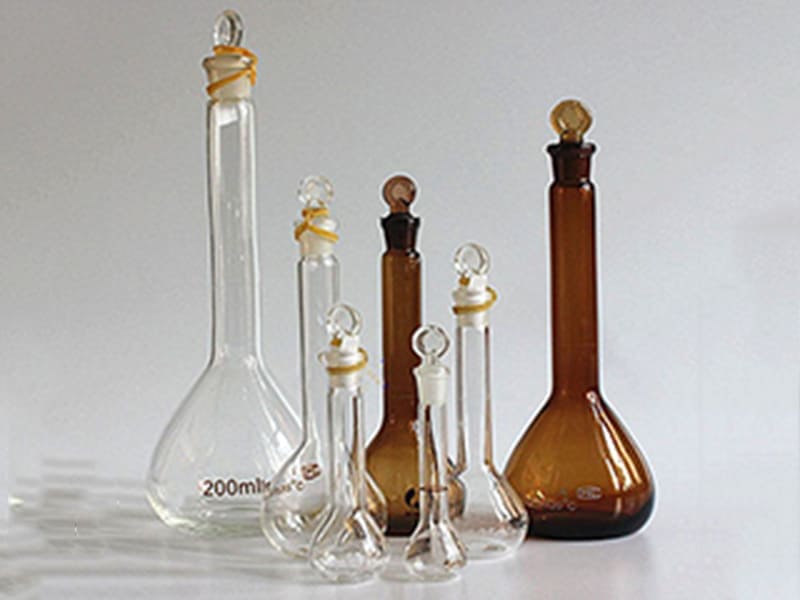
Effective Cleaning and Maintenance of Laboratory Volumetric Flasks
Understanding the proper techniques for cleaning and maintaining volumetric flasks is crucial for any laboratory professional or student. This guide provides detailed steps and precautions to ensure the accuracy and longevity of these essential lab tools. Follow these guidelines to keep your volumetric flasks in top condition.
Cleaning Methods:
- Soaking: Soak the volumetric flask in warm water with detergent. Gently wipe the surface with a soft cloth or sponge, being careful not to use abrasive materials that might scratch the surface.
- Rinsing: Thoroughly rinse with clean water, paying special attention to the mouth and neck of the flask. If there are hard-to-remove stains, use an appropriate amount of detergent, then rinse thoroughly with water.
- Sterilizing: You may use alcohol or other sterilizing agents to disinfect the volumetric flask and remove bacteria and impurities.
Step-by-Step Cleaning Protocols for Volumetric Flasks
Ensuring the cleanliness and accuracy of your volumetric flasks involves a series of meticulous steps. Here’s a detailed guide to the step-by-step protocols for each major cleaning method, helping you maintain the integrity and longevity of your laboratory glassware.
1. General Soaking and Cleaning:
- Step 1: Prepare a cleaning solution with mild detergent and warm water. The typical concentration should be about 2-5% of detergent.
- Step 2: Submerge the volumetric flask completely in the solution and let it soak for 15-30 minutes. For heavier residues, consider soaking for up to 2 hours.
- Step 3: Gently scrub the inner and outer surfaces using a soft brush or sponge. Be thorough yet gentle to avoid scratching the glass.
- Step 4: Rinse the flask several times with distilled or deionized water, ensuring all detergent is removed.
- Step 5: Drain the excess water and allow the flask to air dry on a clean rack, preferably upside down.
2. Acid Washing:
- Step 1: Prepare a dilute acid solution (e.g., 10% hydrochloric acid or nitric acid) in a plastic container. Always add acid to water, never the reverse.
- Step 2: Carefully immerse the volumetric flask in the acid bath and allow it to soak for 5-10 minutes. For more persistent inorganic residues, soaking might need to be extended up to 30 minutes.
- Step 3: Remove the flask and neutralize the acid with a baking soda solution or rinse thoroughly with water.
- Step 4: Follow up with several rinses of distilled or deionized water to ensure complete removal of the acid.
- Step 5: Dry the flask thoroughly in an inverted position on a clean rack.
3. Alkali Cleaning for Organic Residues:
- Step 1: Prepare a solution of dilute sodium hydroxide or potassium hydroxide.
- Step 2: Soak the volumetric flask in the solution for a period, typically 30 minutes to an hour, to saponify fats and break down proteins.
- Step 3: After soaking, scrub gently if necessary, then rinse the flask thoroughly with distilled or deionized water to remove all traces of the alkali.
- Step 4: Dry the flask completely before storing or using it.
4. Ultrasonic Cleaning:
- Step 1: Fill the ultrasonic cleaner with a suitable cleaning solution and distilled water.
- Step 2: Place the volumetric flask in the cleaner, ensuring it is fully submerged.
- Step 3: Run the ultrasonic cleaner as per the manufacturer’s instructions, typically for 5-15 minutes.
- Step 4: After ultrasonic cleaning, rinse the flask thoroughly with distilled water and dry.
Following these detailed step-by-step cleaning protocols will help ensure that your volumetric flasks are free from contaminants and residues, maintaining the precision necessary for your critical laboratory measurements. Regular adherence to these procedures will extend the usable life of your glassware and contribute to the overall quality and reliability of your experimental results. Always remember to handle and dispose of cleaning solutions safely, adhering to your laboratory’s safety guidelines.
Maintenance Methods:
- Handle with Care: When using the volumetric flask, handle it gently to avoid dropping or bumping, which could cause cracks or breakage.
- Environment Awareness: Ensure that the volumetric flask is used on a stable surface to prevent spills or accidents. Avoid exposure to direct sunlight or heat sources.
- Proper Usage: Select the appropriate technique based on your experimental needs. Avoid overfilling or underfilling the flask to maintain accuracy and avoid reagent waste. Store the flask in a dry, ventilated area away from humidity.
- Regular Inspection: Periodically check the flask for any signs of damage, cracks, or dirt. Address any issues promptly by cleaning or replacing the flask.
- Correct Storage: When not in use, store the flask in a dry, ventilated area away from direct sunlight and moisture. Do not stack them in a way that might cause them to collide or deform. Regularly clean and maintain even those flasks not in frequent use to ensure their longevity and safety.
Precautions:
- Hazardous Materials: Do not use the flask to store harmful substances or corrosive chemicals to avoid endangering personnel and the environment.
- Post-Use Care: Clean the flask promptly after use and allow it to dry or be dried before storage. Regularly clean and maintain even those flasks not in frequent use to ensure their longevity and safety.
Proper cleaning and maintenance of volumetric flasks are crucial for maintaining their accuracy and extending their usable life. Pay attention to correct handling, regular inspection, and proper storage, while adhering to safety guidelines and laboratory protocols. Correct operation and upkeep will prolong the life of the glassware and ensure the reliability and accuracy of your experimental results.
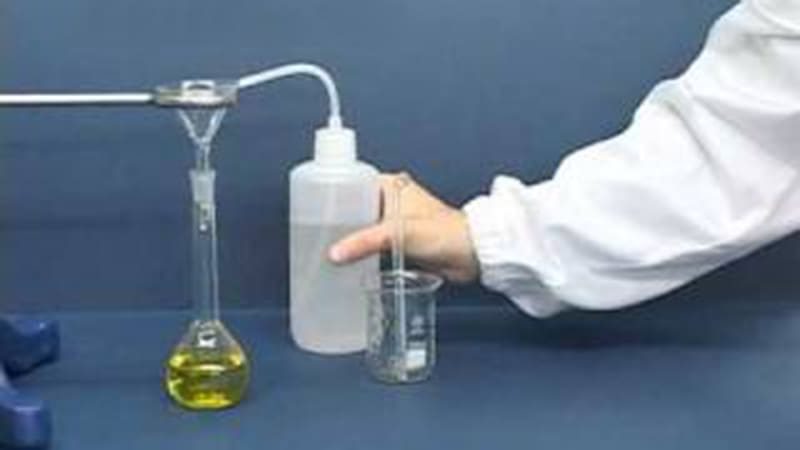
The Chemistry Behind Cleaning Agents for Volumetric Flasks
In the realm of laboratory maintenance, understanding the intricate chemistry of cleaning agents is pivotal. This knowledge ensures the effective and safe removal of residues, contributing to the accuracy and longevity of volumetric flasks. Here’s an insight into the molecular dynamics of detergents, acids, alkalis, and other specialized cleaners.
1. Detergents:
- Chemical Composition: Most laboratory detergents are mild and non-ionic surfactants. They consist of molecules with a hydrophobic tail that attaches to oil and grease and a hydrophilic head that makes the molecule soluble in water.
- Action on Residues: Detergents work by surrounding and isolating dirt or organic material, making it easier to rinse away. They are effective against a wide range of organic compounds and some biological materials.
- Precautions: Use in dilute concentrations to avoid leaving any filmy residues themselves. Ensure thorough rinsing with distilled or deionized water.
2. Acids:
- Common Acids Used: Hydrochloric acid and nitric acid are commonly used to remove inorganic deposits like metal oxides or scales.
- Action on Residues: Acids dissolve metal oxides and react with basic residues. For example, hydrochloric acid can dissolve calcium carbonate deposits.
- Precautions: Acid cleaning should be done with caution, using appropriate personal protective equipment (PPE), and ensuring good ventilation. Always add acid to water, not the reverse, to avoid exothermic reactions. Dispose of acid waste properly.
3. Alkalis:
- Common Alkalis Used: Sodium hydroxide or potassium hydroxide can be used to saponify fats and break down organic material.
- Action on Residues: Alkalis are effective in breaking down and emulsifying fats, proteins, and other organic matter. They are particularly useful in cleaning biological materials or heavy organic residues.
- Precautions: Similar to acids, handle with care. Alkalis can cause severe burns and must be used with proper PPE. They should be rinsed thoroughly to avoid any hazardous reactions with acidic residues in subsequent uses.
4. Specialized Cleaning Agents:
- Chromic Acid: A mixture of potassium dichromate and concentrated sulfuric acid, used for heavy-duty cleaning. It is highly effective but very corrosive and toxic, making it less popular in modern labs.
- Enzymatic Cleaners: These are bio-based cleaners that use enzymes to break down proteins and other organic materials. They are becoming more popular due to their specificity and reduced environmental impact.
5. Interaction with Different Types of Residues:
- Organic Residues: Detergents and alkalis are effective against fats, oils, proteins, and general organic buildup.
- Inorganic Residues: Acids are used to treat inorganic residues, such as mineral deposits or metal oxides.
- Biological Materials: Enzymatic cleaners and detergents can be used to break down biological substances like blood or tissue.
6. Precautions and Safety Measures:
- Always wear appropriate PPE, including gloves and goggles, when handling cleaning chemicals.
- Be aware of the compatibility of cleaning agents with the glassware material.
- Ensure proper ventilation when using volatile or strong-smelling chemicals.
- Understand and follow waste disposal regulations for chemical cleaners.
By grasping the fundamental chemistry of various cleaning agents, laboratory personnel can tailor their cleaning approaches to different types of residues and contaminants. This not only enhances the effectiveness of cleaning but also fortifies the safety and sustainability of laboratory practices. Remember, a well-maintained volumetric flask is foundational to precise and reliable measurements in any scientific endeavor.
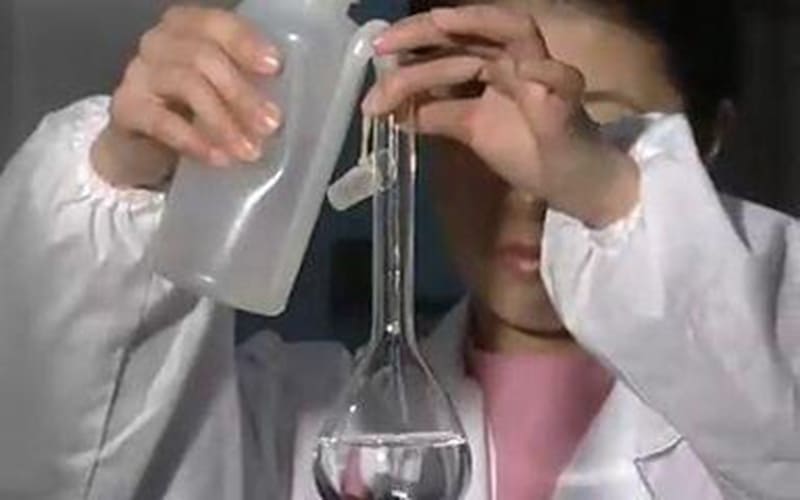
Impact of Water Quality on Cleaning Volumetric Flasks
The role of water quality in the cleaning process of volumetric flasks is a crucial aspect often overlooked. Ensuring the use of the right type of water, particularly distilled or deionized water, is fundamental in preventing residue buildup and avoiding the introduction of additional contaminants.
Importance of Water Quality
- Residue-Free Results: Tap water can contain minerals and organic compounds that leave residues on glassware after evaporation. Distilled or deionized water, on the other hand, is free from these contaminants, ensuring that no residues are left behind after cleaning and rinsing.
- Prevention of Scale Buildup: Hard water, which is high in mineral content, can lead to scale buildup over time. This is particularly detrimental in volumetric flasks where precision is key. The use of distilled or deionized water eliminates the risk of scale and mineral deposit formation.
- Consistent Cleaning Efficacy: The absence of minerals in distilled or deionized water ensures that the cleaning agents can work more effectively. Minerals in hard water can react with detergents and reduce their cleaning efficiency.
Implementing Best Practices
- Rinsing: Always perform the final rinse of cleaned volumetric flasks with distilled or deionized water. This step is crucial in ensuring that no tap water residues are left behind, which could affect the accuracy of volumetric measurements.
- Preparing Solutions: When preparing cleaning solutions, particularly dilute acids or bases, use distilled or deionized water to maintain the purity and intended strength of the solution.
- Storing Water: Ensure that the distilled or deionized water is stored properly to prevent contamination. Use clean, dedicated containers and keep them covered to avoid dust and other airborne contaminants.
The quality of water used in the cleaning process is as crucial as the cleaning agents themselves. Distilled or deionized water should be an integral part of the cleaning regimen for volumetric flasks, helping to maintain the accuracy and longevity of these essential lab tools. Implementing these water quality measures will contribute significantly to the reliability and precision of your scientific work, ensuring that every measurement is as accurate and contamination-free as possible.
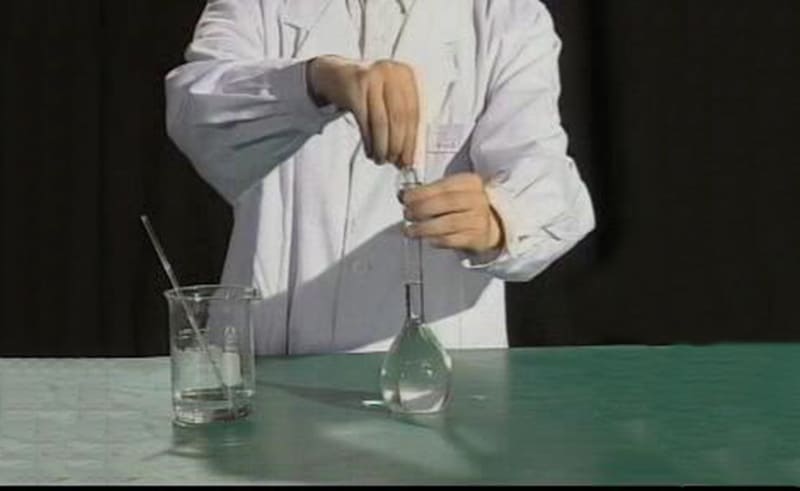
Handling and Preventing Common Issues in Volumetric Flask Maintenance
In the meticulous world of volumetric measurements, even minor issues like water spots, streaks, or cloudiness can compromise the accuracy of results. Understanding how to address and prevent these common issues is vital for maintaining the integrity of your volumetric flasks. Here are some tips for tackling these problems and keeping your flasks clear and precise.
Water Spots and Streaks
- Causes: Water spots and streaks are often caused by the minerals in non-distilled water evaporating and leaving residues, or by improper drying techniques.
- Prevention: Always use distilled or deionized water for the final rinse to prevent mineral deposits. Ensure that flasks are inverted to drain completely and dried in a dust-free environment.
- Remedy: If spots or streaks have already formed, rinse the flask with a mild acid like vinegar (acetic acid) diluted in distilled water, followed by a thorough rinse with distilled water.
Cloudiness
- Causes: Cloudiness can be caused by etching from harsh chemicals, scratches from abrasive cleaning, or deposits from long-term use.
- Prevention: Use gentle cleaning agents and soft brushes or sponges. Avoid harsh chemicals unless absolutely necessary, and always dilute them appropriately. Regularly inspect and clean your flasks to prevent buildup.
- Remedy: If cloudiness is due to removable deposits, a soak in an appropriate cleaning solution followed by thorough rinsing may restore clarity. However, if the glass is etched or scratched, it may be permanent, and the flask should be replaced to ensure accuracy.
Tips for Preventing and Handling Issues:
- Proper Cleaning Techniques: Always follow proper cleaning techniques, using the right agents and tools for the material of your flask. Gentle, regular cleaning prevents the buildup that leads to these issues.
- Regular Inspections: Make it a habit to inspect your flasks regularly for any signs of trouble, including before and after each cleaning session.
- Immediate Action: If you notice spots, streaks, or cloudiness, take immediate action to clean the flask again, as residues can become more difficult to remove over time.
- Storage Conditions: Store your flasks in a clean, stable environment. Dust and exposure to chemicals even when not in use can lead to these common issues.
Maintaining the clarity and cleanliness of volumetric flasks is essential for accurate measurements. By understanding the causes and remedies for water spots, streaks, and cloudiness, you can take proactive steps to prevent these issues. Regular, gentle cleaning with the right materials, proper drying, and storage, and prompt attention to any problems will keep your flasks in top condition, ensuring that they continue to provide reliable results in all your laboratory endeavors.
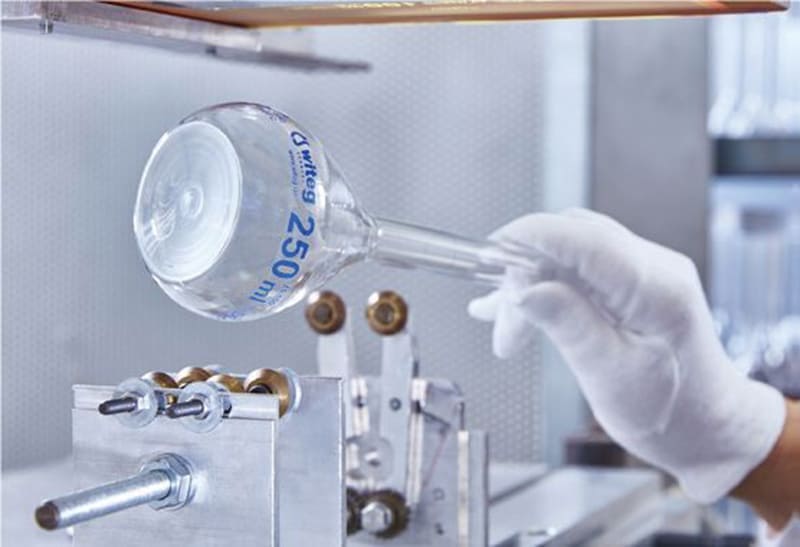
Customized Approach for Different Materials in Volumetric Flask Maintenance
Volumetric flasks are not a one-material-fits-all scenario. They are made from various materials, each with unique properties and cleaning requirements. Understanding how to tailor your cleaning and maintenance approach to the specific material of your volumetric flask is crucial for ensuring its longevity and accuracy. Here are some guidelines for the most common materials: borosilicate glass, soda-lime glass, and various types of plastic.
Borosilicate Glass:
- Characteristics: Known for its excellent thermal and chemical resistance, borosilicate glass is less likely to crack under thermal stress and is resistant to corrosive chemicals.
- Cleaning Advice: Use mild detergents and avoid extreme pH cleaning agents unless necessary. Borosilicate is durable but to maintain its integrity, avoid sudden temperature changes and mechanical shocks.
- Maintenance Tips: Inspect for stress cracks, particularly after exposure to high temperatures or corrosive chemicals. Even though it’s durable, handling with care is still paramount.
Soda-Lime Glass:
- Characteristics: More common and less expensive than borosilicate glass, soda-lime glass is widely used but more prone to thermal shock and chemical attack.
- Cleaning Advice: Gentle cleaning is key. Use neutral or mild alkaline detergents and avoid strong acids and bases. Be mindful of etching and scratching, which can occur with harsh mechanical cleaning.
- Maintenance Tips: Always cool and heat gradually to avoid thermal stress. Regularly check for etching or cloudiness, which can indicate chemical degradation.
Plastic Volumetric Flasks:
- Characteristics: Plastics like polyethylene, polypropylene, or PTFE are used for volumetric flasks, especially when breakage is a concern or specific chemical resistance is required.
- Cleaning Advice: Understand the chemical compatibility of your plastic. Some plastics may be sensitive to solvents, acids, or bases. Typically, mild detergents and warm water are safe for most plastics, and abrasive scrubbing should be avoided to prevent surface scratches.
- Maintenance Tips: Check for warping or discoloration, which can indicate chemical damage or aging. Be cautious of using strong light sources for extended periods, as some plastics can degrade under UV light.
The material of your volumetric flask dictates the specifics of its care and cleaning. No matter the material, always refer to the manufacturer’s guidelines for specific advice on cleaning agents and methods. By understanding and respecting the material properties of your volumetric flasks, you can ensure their longevity and reliability in your laboratory’s critical measurements. Each material requires a nuanced approach to maintenance, reflecting its particular strengths and vulnerabilities. Proper care tailored to the material not only extends the life of the flask but also ensures the accuracy and integrity of your measurements.
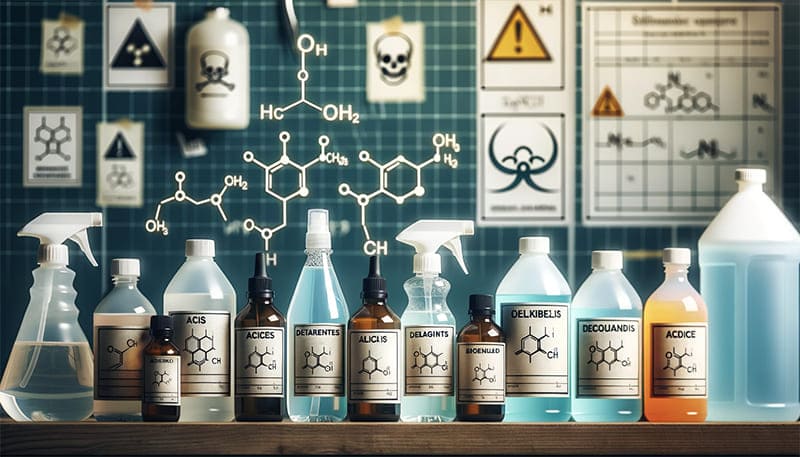
Advanced Cleaning Techniques for Stubborn Residues
Sometimes, volumetric flasks may acquire stubborn residues that standard cleaning methods can’t remove. Here are some advanced techniques:
- Chemical Soaks: For organic residues, soaking in a mixture of chromic acid or a base bath can be effective. However, these chemicals are hazardous and should be used with extreme caution, following all safety protocols.
- Ultrasonic Bath: An ultrasonic bath can help dislodge particles stuck to the flask’s surface, providing a deep clean without the need for abrasive scrubbing.
- Rinse with Solvents: For oil or grease, rinsing with an appropriate solvent like acetone or ethanol before the standard cleaning procedure can be beneficial.
Ensuring Accuracy: Calibration and Care
Over time, the markings on volumetric flasks may wear off, or the flask may warp slightly due to thermal stress. It’s essential to:
- Regular Calibration: Ensure that your flasks are periodically calibrated, especially after extensive use or if they have been subject to harsh chemicals or temperature changes.
- Careful Use of Stoppers: Ensure that the stoppers or caps used are clean and fit well. A poor seal can lead to evaporation or contamination.
User Responsibility and Training
- Proper Training: All lab personnel should be trained in the correct use, cleaning, and storage of volumetric flasks. Awareness about the impact of improper handling on experimental accuracy is crucial.
- Responsibility: Encourage a culture of responsibility where each user cleans and stores the equipment correctly after use. This habit ensures that flasks are always ready for the next user.
Environmental and Safety Considerations
While maintaining the cleanliness and integrity of volumetric flasks, it’s also vital to consider the environmental and safety aspects:
- Eco-friendly Detergents: Use biodegradable, non-toxic detergents for cleaning when possible.
- Proper Disposal: Dispose of any chemical waste or broken glassware according to your institution’s safety protocols.
- Safety Gear: Always wear appropriate protective gear, including gloves and eye protection, when cleaning or handling chemicals.

Safety Precautions for Handling Broken Glassware
Working with glassware, especially in a laboratory setting, always carries the risk of breakage. Handling and disposing of broken or damaged volumetric flasks safely is crucial to prevent injuries and maintain a safe working environment. Here are some essential safety precautions and first-aid tips for dealing with broken glassware.
Disposing of Broken Glassware:
- Immediate Action: As soon as breakage occurs, alert those nearby and restrict access to the area to prevent injuries.
- Proper Equipment: Wear appropriate personal protective equipment (PPE) such as safety gloves, goggles, and lab coat when dealing with broken glass.
- Clean-up Process: Use a brush and dustpan, or a similar tool, to collect all glass fragments. Never use your hands directly, even with gloves.
- Disposal: Dispose of the broken glass in a designated glass disposal container, not in regular waste bins. Ensure that the disposal container is labeled and made of a puncture-resistant material.
- Notification: Label the area where the glass was broken until you are certain all pieces have been cleared. Notify the appropriate personnel to handle the disposal if needed.
First-Aid Tips in Case of Accidents:
- Cuts or Puncture Wounds: If you or someone else gets cut, encourage gentle bleeding to flush out dirt, then rinse the wound under running water. Apply a sterile dressing and seek medical attention for severe cuts.
- Eye Injuries: If glass gets into the eyes, do not rub them. Rinse the eye with clean water or an eye wash solution for at least 15 minutes and seek immediate medical attention.
- Ingestion: If there’s a possibility that broken glass has contaminated any substances that were then ingested, seek immediate medical advice.
Handling broken glassware safely is a critical aspect of laboratory safety. By following proper procedures for disposal and being prepared with first-aid measures, you can minimize the risk of injury and maintain a safe, efficient working environment. Always prioritize safety and ensure that all laboratory personnel are trained in these essential practices.
Conclusion
Embark on a journey to master the precision and longevity of your laboratory’s volumetric flasks. With the right care, attention, and understanding, you can maintain impeccable accuracy in every measurement. Remember, the key to flawless scientific endeavors lies in the pristine condition of your equipment. For more insightful tips and a complete guide to volumetric flasks, visit glasswaree. Dive deeper into the world of volumetric flask mastery today!










